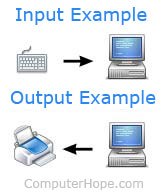

| HOME |
INPUT DEVICE |
OUTPUT DEVICE |
INPUT OUTPUT DEVICE |
STORAGE DEVICE |
 An input device sends information to a computer system for processing, and an output device reproduces or displays the results of that processing. Depending on the interaction, a device can be both, referred to as an input/output or I/O device.
An input device sends information to a computer system for processing, and an output device reproduces or displays the results of that processing. Depending on the interaction, a device can be both, referred to as an input/output or I/O device.
For example, as you can see in the top half of the image, a keyboard sends electrical signals, which are received by the computer (input). Those signals are then interpreted by the computer and displayed on the monitor as text (output). In the lower half of the image, the computer sends data to a printer, which will print the data onto a piece of paper (output).
An input device can send data to another device, but it cannot receive data from another device. Examples of an input device include a computer keyboard and mouse, which can send data (input) to the computer, but they cannot receive or reproduce information (output) from the computer.
An output device can receive data from another device, but it cannot send data to another device. Examples of an output device include a computer monitor, projector, and speakers, which can receive data (output) from the computer, but they cannot send information (input) to the computer.
An input/output device can send data to another device and also receive data from another device. Examples of an input/output include a computer CD-RW drive and USB flash drive, which can send data (input) to a computer and also receive data (output) from a computer.
Source : https://www.computerhope.com/issues/ch001355.htm